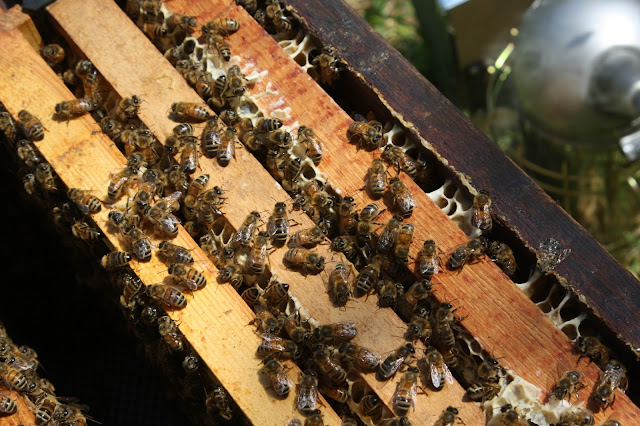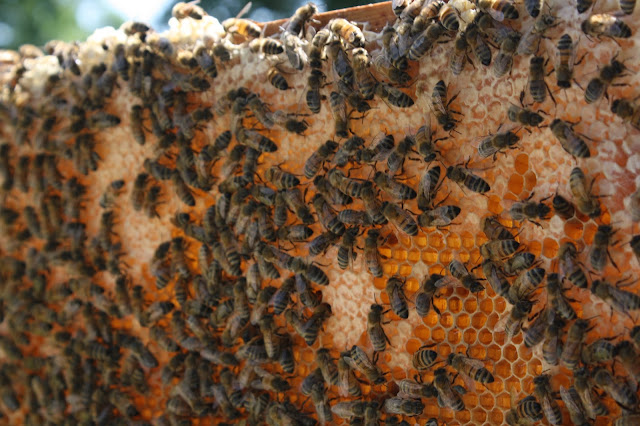Well, there is a long answer and a short answer to that question:
Short is: I still have a colony of bees that I am readying for winter. No, honey for us this year, but lots of other bee keepers say that is no surprise in the first year. The long answer is below, here are some pictures of me with my little bee-keeper assistants to ready you for it.
 |
| Little Louis Fox & Mrs Fox ready for an inspection Photo by Una |
 |
| Little Louis Fox ready to check his bees Photo by Una |
 |
| Little Una Fox puts the queen guard back on the hive Photo by Louis |
So, long story is: I got more relaxed with inspections and things seemed to be chugging along ok. The colony built up in size and so I added my supers to the brood box and waited for the bees to do something. They didn't take much interest, so after speaking with my 'bee guru' (Malcolm) I added some frames of drawn comb because, apparently, bees can sometimes be a bit uninterested in the hard work of making the wax honeycomb to store the honey in. Lazy bees!
By the time I had collected the drawn comb from Malcolm my bees had made a start on drawing the frames of foundation that I had given them in the super. Clever bees!
 |
| Bees on the brood frames Photo by Una |
I was a very happy, excited, quietly confident beginner bee-keeper, when I went down to the hive one sunny morning and I immediately knew there was something wrong. There were very few bees outside the hive despite it being past 11 on a sunny morning. I couldn't check them until later that day when I discovered there were very few bees inside the hive either. After a bit of panic and calling a few experienced bee keepers for advice I had to accept my lovely gentle queen had left me.
A fellow bee keeper popped over with a frame of brood (baby bees) in case I needed to rear a new queen. How nice is that? Friday evening, just pop over to some woman I don't know's house, give a stuttering wreck of a bee keeper a frame of precious brood in case she needs to re-queen a colony of bees!
Fortunately there was a new young queen in the hive. I didn't find her straight away, but once I had seen her, I then had to leave the hive undisturbed for a few weeks to give her the chance to fly off, mate and (hopefully) return to the hive ready to spend the rest of her life laying eggs. This has all seemed to happen in order.
But my new queen is not so chilled and calm as my old queen and the mood of my colony is very different. They are quicker to become agitated when you inspect them, louder, the guard bees quicker to try and see you off and a lot more persistent in their job. The difference in the nature of my two colonies is huge and I miss my old queen.
Since then my new young colony have eaten all the honey stores that were in the super, hence no honey for me. They've also had to fight off marauding wasps that tried to eat their honey stores. This they have done admirably, but then considering their temperament I'm not surprised.
I'm undaunted. I'm getting this lovely lot ready for winter and planning to get a new colony next year and maybe try re-queening. I've already got my name down for another bee keeping course, Bee Improvement for All, this in the hope of better swarm management and a gentler colony. The next big challenge is getting this colony through the winter. I'm treating them for varroa to get them as healthy as possible and starting to feed them so they can make enough honey to store through the lean winter months. Wish me luck

















No comments